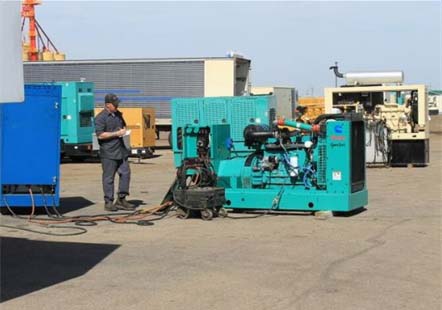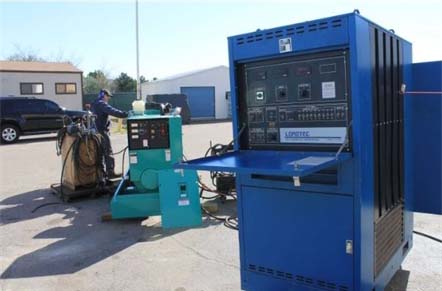|
 The purpose of an emergency generator set is to provide a reliable source of power to your facility or commercial operation during an emergency situation when power from the grid is suddenly lost or is not available in your environment. In the event of a power failure, you should have peace of mind that your backup power source will kick into action on a moment's notice. But what happens when the power goes out and your genset does not function as expected? The result can often be costly and sometimes catastrophic. The purpose of an emergency generator set is to provide a reliable source of power to your facility or commercial operation during an emergency situation when power from the grid is suddenly lost or is not available in your environment. In the event of a power failure, you should have peace of mind that your backup power source will kick into action on a moment's notice. But what happens when the power goes out and your genset does not function as expected? The result can often be costly and sometimes catastrophic.
This is precisely the reason generator load bank testing is an essential piece of a comprehensive preventative generator maintenance plan, which you should ideally have conducted on your genset(s) each year. Load bank testing helps to ensure that your generator will be fully dependable and operational, as well as completely capable of the highest possible load it may be required to handle at any critical point in time.
What is Generator Load Bank Testing?
A generator load bank test involves an examination and assessment of a genset. It verifies that all primary components of the generator set are in proper working condition under loaded conditions. The equipment used to conduct a load bank test produces artificial loads on the generator by bringing the engine to an appropriate operating temperature and pressures. This is especially important for standby and emergency generator sets that do not run very often and/or may not be exposed to carrying heavy loads on a frequent basis. The general rule is - if your generator is not exposed to higher than 30% of its rated kW load then you should be considering a load test.
A load bank test ensures that your generator will run property when it’s needed so that you can fully depend on it during an emergency situation. The key to a proper load bank test is that it tests your generator at its full kilowatt (kW) output rating. Because many generators do not regularly operate at their full kW rating, it's especially important that you verify your generator can actually produce the highest possible horsepower that may be required - while at the same time maintaining adequate temperature and pressure levels that will allow it to run as long as necessary.
How does a Load Bank Test Work?
When a load bank test is implemented, an artificial load is placed on the generator. The test is timed and gradually increases the kW load in specific increments. Each time the kW load is increased, engine and alternator parameters are recorded. Testing the generator's ability to handle the boost, and its ability to continue functioning at the highest possible level for a sustained period of time. The equipment needed to complete the test includes a load bank (machine with kW rated sizes and battery like cables). For more information and to see some load bank tests in action be sure to check out our video above that includes examples of our technicians performing load tests at our facility.
Wet-Stacking
When a diesel engine powered generator is not used frequently or only run on light loads, it can be prone to experiencing unburned fuel and soot buildup in the exhaust system. This is called 'wet-stacking.' When wet-stacking occurs, the genset is likely to perform poorly, to endure damage, can become a fire hazard, and can even lead to complete failure. During a load bank test, the generator is allowed to run at full power and full temperature. This will cause any wet-stacking to burn off. Hence, a load bank test actually serves two purposes: 1) it tests the generator to determine whether it will function properly and efficiently on all levels; and 2) it eliminates any wet-stacking that may have built up within the generator.
Benefits of Load Bank Testing
There are multiple reasons gensets should undergo a load bank test on an annual basis, including the following:
• Verifies the gensets capabilities opposed to just routinely starting it up.
• Problems discovered early can be significantly less expensive and prevents future major issues.
• Helps to avoid wet-stacking and cleans out carbon deposits.
• Verifies the engine cooling systems will perform while under load.
• Provides assurance that the genset should work properly when you need it most.
What's Included in Generator Source's Load Bank Testing?
Generator Source runs a restistive load bank test on every generator we own and sell. Upon completion of a successful load bank test, which is timed out with increasing intervals until it is stepped up to a full load. In addtion we provide our customers with a Load Bank Report that contains thorough, comprehensive test results, which are available on all of our name brand commercial and industrial gensets.

• kW Load
• AC Voltage
• Hertz
• Oil Pressure
• Amperage Rating
• Voltage Tested
• Additional Notes and Comments.
For more than three decades Generator Source has set the standard for dependability. When you purchase and install a genset at your facility or in your industrial environment you should be confident that it will work properly. When you rely on Generator Source for your generator purchase, you are provided with certainty that your generator will start up and work to its fullest potential when it arrives. In addition to load tests, we also conduct more involved testing and our famed 31 point inspection process. Our aim is to make sure our customers have excellent equipment (either new or used) that is reliable. For this reason, we offer our Certified Generator Seal of Approval on all of the gensets we offer. For more information Contact Us today or call 800-853-2073.
|